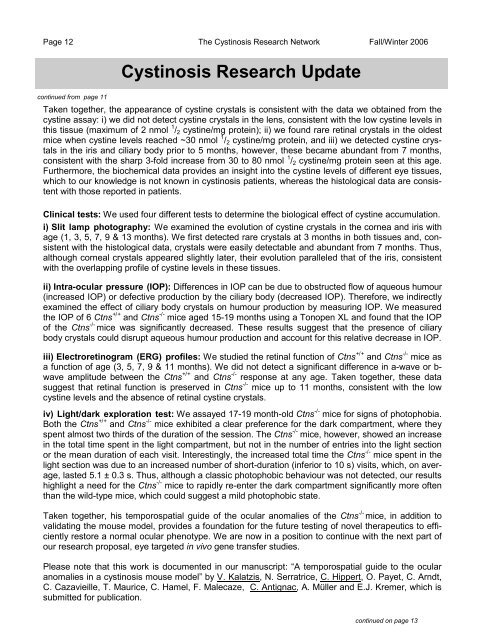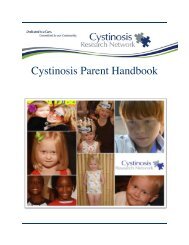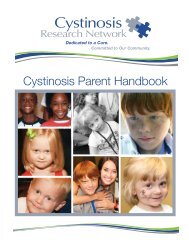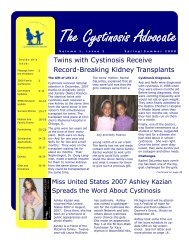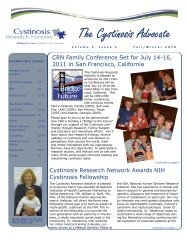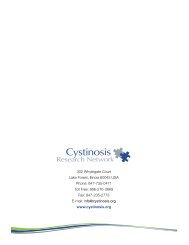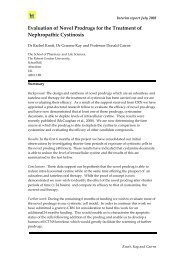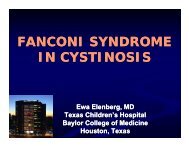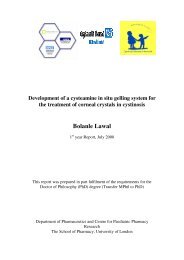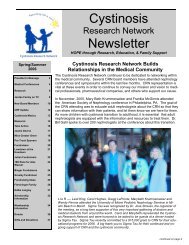Cystinosis Newsletter - Cystinosis Research Network
Cystinosis Newsletter - Cystinosis Research Network
Cystinosis Newsletter - Cystinosis Research Network
You also want an ePaper? Increase the reach of your titles
YUMPU automatically turns print PDFs into web optimized ePapers that Google loves.
Page 12 The <strong>Cystinosis</strong> <strong>Research</strong> <strong>Network</strong> Fall/Winter 2006<br />
continued from page 11<br />
<strong>Cystinosis</strong> <strong>Research</strong> Update<br />
Taken together, the appearance of cystine crystals is consistent with the data we obtained from the<br />
cystine assay: i) we did not detect cystine crystals in the lens, consistent with the low cystine levels in<br />
this tissue (maximum of 2 nmol 1 /2 cystine/mg protein); ii) we found rare retinal crystals in the oldest<br />
mice when cystine levels reached ~30 nmol 1 /2 cystine/mg protein, and iii) we detected cystine crystals<br />
in the iris and ciliary body prior to 5 months, however, these became abundant from 7 months,<br />
consistent with the sharp 3-fold increase from 30 to 80 nmol 1 /2 cystine/mg protein seen at this age.<br />
Furthermore, the biochemical data provides an insight into the cystine levels of different eye tissues,<br />
which to our knowledge is not known in cystinosis patients, whereas the histological data are consistent<br />
with those reported in patients.<br />
Clinical tests: We used four different tests to determine the biological effect of cystine accumulation.<br />
i) Slit lamp photography: We examined the evolution of cystine crystals in the cornea and iris with<br />
age (1, 3, 5, 7, 9 & 13 months). We first detected rare crystals at 3 months in both tissues and, consistent<br />
with the histological data, crystals were easily detectable and abundant from 7 months. Thus,<br />
although corneal crystals appeared slightly later, their evolution paralleled that of the iris, consistent<br />
with the overlapping profile of cystine levels in these tissues.<br />
ii) Intra-ocular pressure (IOP): Differences in IOP can be due to obstructed flow of aqueous humour<br />
(increased IOP) or defective production by the ciliary body (decreased IOP). Therefore, we indirectly<br />
examined the effect of ciliary body crystals on humour production by measuring IOP. We measured<br />
the IOP of 6 Ctns +/+ and Ctns -/- mice aged 15-19 months using a Tonopen XL and found that the IOP<br />
of the Ctns -/- mice was significantly decreased. These results suggest that the presence of ciliary<br />
body crystals could disrupt aqueous humour production and account for this relative decrease in IOP.<br />
iii) Electroretinogram (ERG) profiles: We studied the retinal function of Ctns +/+ and Ctns -/- mice as<br />
a function of age (3, 5, 7, 9 & 11 months). We did not detect a significant difference in a-wave or bwave<br />
amplitude between the Ctns +/+ and Ctns -/- response at any age. Taken together, these data<br />
suggest that retinal function is preserved in Ctns -/- mice up to 11 months, consistent with the low<br />
cystine levels and the absence of retinal cystine crystals.<br />
iv) Light/dark exploration test: We assayed 17-19 month-old Ctns -/- mice for signs of photophobia.<br />
Both the Ctns +/+ and Ctns -/- mice exhibited a clear preference for the dark compartment, where they<br />
spent almost two thirds of the duration of the session. The Ctns -/- mice, however, showed an increase<br />
in the total time spent in the light compartment, but not in the number of entries into the light section<br />
or the mean duration of each visit. Interestingly, the increased total time the Ctns -/- mice spent in the<br />
light section was due to an increased number of short-duration (inferior to 10 s) visits, which, on average,<br />
lasted 5.1 ± 0.3 s. Thus, although a classic photophobic behaviour was not detected, our results<br />
highlight a need for the Ctns -/- mice to rapidly re-enter the dark compartment significantly more often<br />
than the wild-type mice, which could suggest a mild photophobic state.<br />
Taken together, his temporospatial guide of the ocular anomalies of the Ctns -/- mice, in addition to<br />
validating the mouse model, provides a foundation for the future testing of novel therapeutics to efficiently<br />
restore a normal ocular phenotype. We are now in a position to continue with the next part of<br />
our research proposal, eye targeted in vivo gene transfer studies.<br />
Please note that this work is documented in our manuscript: “A temporospatial guide to the ocular<br />
anomalies in a cystinosis mouse model” by V. Kalatzis, N. Serratrice, C. Hippert, O. Payet, C. Arndt,<br />
C. Cazavieille, T. Maurice, C. Hamel, F. Malecaze, C. Antignac, A. Müller and E.J. Kremer, which is<br />
submitted for publication.<br />
continued on page 13


